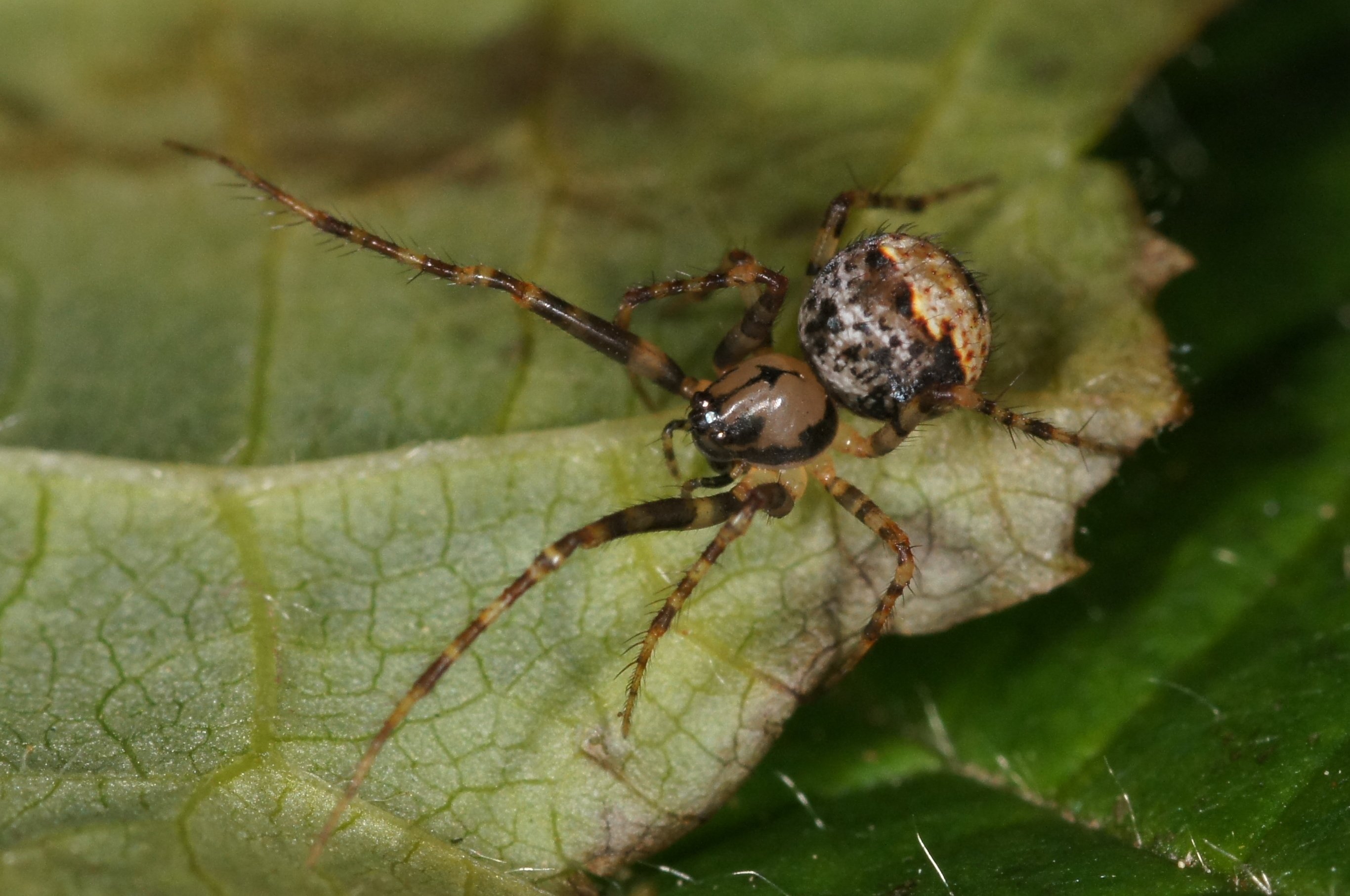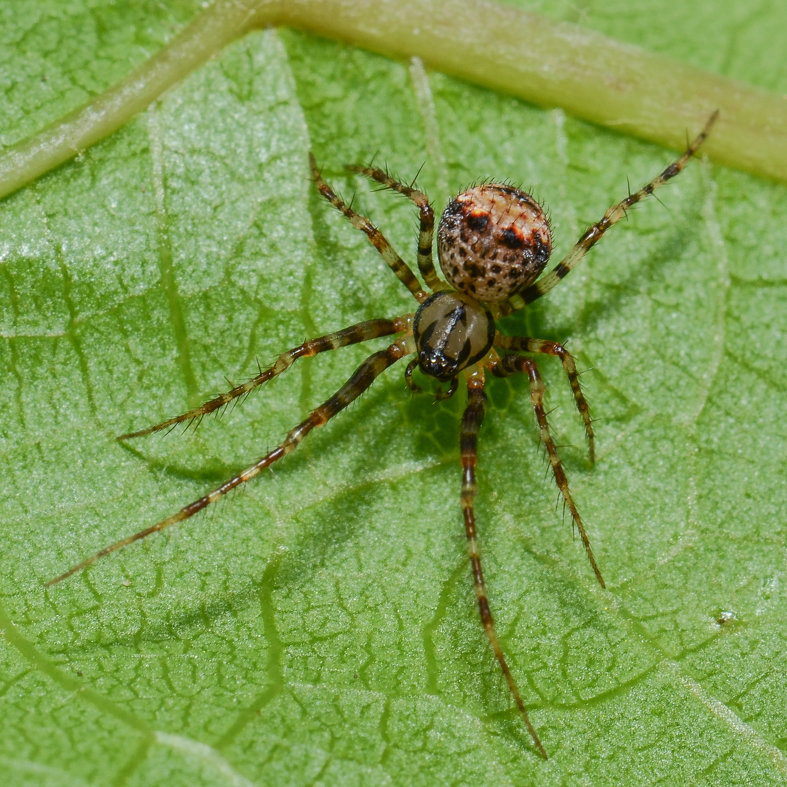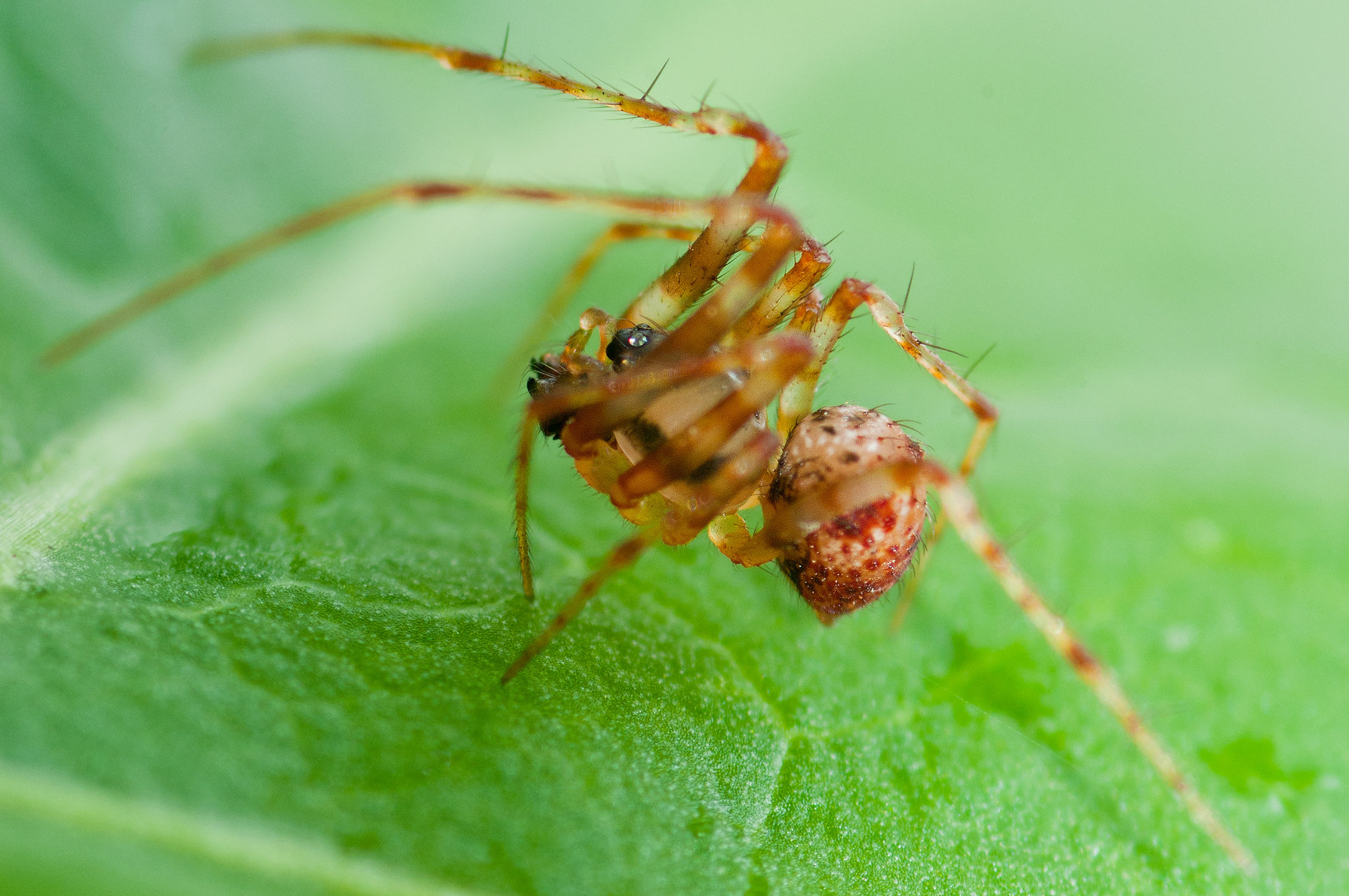Spider of the Year 2021
Two-humped pirate spider Ero furcata (Villers, 1789)
The two-humped pirate spider, Ero furcata (Villers, 1789), belongs to the similarly named family of the pirate spiders (Mimetidae). Worldwide this spider family has 154 species. Ten species are known from Europe, nine of which are listed under the genus Ero. As well as Ero furcata, three further species in this genus are primarily distributed in Central Europe: Ero aphana (Walckenaer, 1802), E. cambridgei Kulczyński, 1991 und E. tuberculata (De Geer, 1778).
The two-humped pirate spider is distributed across the Palaearctic region. In Central Europe it is mostly restricted to plains and foothills (up to 800 m altitude), but in montane regions it can extend to 1,500 m. In Austria there are even records from scree slopes up to 2,000 m above sea level. You can find the pirate spider in natural settings, typically on the floor of different forest types, but also in the lower (and sometime middle) trunk region of trees. Otherwise, they are found at the edges of forests, in bushes and warm localities. The two-humped pirate spider is not considered endangered.
Text: Christoph Hörweg
Description
The body length of males is 2.5–3 mm, of females 4.5–4.8 mm. The cephalothorax is raised in the middle, light brown in colour and shows characteristic black markings. The abdomen is short and noticeably rounded, also light brown to yellow in colour with dark patches and two blunt humps near the front. The legs are mostly with clear ring-like markings, and the first two pairs of legs are longer than the remaining legs. The pirate spider is, as its name implies, a robber and only eats other spiders, especially web-building species. The pirate spider does not build a web itself, but deliberately enters the webs of animals such as cobweb spiders during the evening or the night. Here, it skillfully plucks the silk, pretending to be a prey item that has landed in the web. Attracted in this way, the owner of the web is then grabbed by the pirate spider’s long front legs, bitten in the leg and finally sucked dry.
In Central Europe there are – as noted above – three other rarer species, albeit with a similar lifestyle. Also with two humps on the abdomen is Ero cambridgei, which can be found throughout the year in wet habitats like moorland or flooded meadows. It is smaller than Ero furcata. The four-humped Ero aphana is found at the edges of pine forests and bushes and is mostly active from April to August in warmer localities. The large Ero tuberculata also has four humps, the front pair being particularly large. This rare species can also be found in pine forests and wet habitats.
Ecology
During the day the two-humped pirate spider sits, usually with its legs retracted, hidden beneath leaves or twigs and is thus quite difficult to find. More easily discovered is the characteristic egg sac, produced late in summer. The egg sac is drop-shaped, about 4 mm across and is made up of several different layers of silk. The innermost is a thin white layer of fine threads, the middle layer is made of thicker, stronger silk which is tightly packed over the inner layer, and there is an outer layer of frizzy, wiry strands. The egg sac is typically hung beneath a protrusion, leaf or twig on a thin, but stiff, ca. 15 mm long thread. Hanging the egg sac in this way may offer protection against predators which would eat the eggs, but does not prevent parasitism by animals like ichneumon wasps which can affect up to 40% of the egg sacs. The sacs themselves usually contain only 6–8 eggs. Spiderlings hatch after overwintering. The spiders mature by the end of spring and then build their own egg sacs, which hatch during summer. In this way Ero furcata can be found all year round.
Text: Christoph Hörweg
As a ‛robber among robbers’ the two-humped pirate spider has developed an unusual way of feeding. For this reason it may be a surprise that so far no member of this spider family has been chosen as Spider of the Year. The characteristic egg sac also offers the possibility of drawing attention to the different ways in which spider silk can be produced and used efficiently.
By choosing a Spider of the Year the scientists hope not only to give prominence to a ‛less popular’ group of animals, but that at the same time to gather up-to-date information about its distribution. In this sense: enjoy the Spider of the Year and help document this species with your records or your photos (of the spider and the egg sac!).
The European Spider of the Year is chosen by 84 arachnologists from 27 European countries. Coordination of the vote is by the Natural History Museum of Vienna, in collaboration with the Arachnologischen Gesellschaft (AraGes) and the European Society of Arachnology (ESA).
Christoph Hörweg
Countries involved
Albania, Austria, Belgium, Bulgaria, Croatia, Czech Republic, Denmark, Finland, France, Germany, Great Britain, Hungary, Ireland, Italy, Liechtenstein, Macedonia, The Netherlands, Norway, Poland, Portugal, Serbia, Slovakia, Slovenia, Spain, Sweden, Switzerland.
Supporting societies
- ARABEL - Belgische Arachnologische Vereniging
- ARAGES - Arachnologische Gesellschaft
- BAS - The British Arachnological Society
- CAS - Česká arachnologická společnost
- ESA - European Society of Arachnology
- GIA - Grupo Ibérico de Aracnología
- NATURADATA - Biodiversidade online (Portugal)
- NATURALIS - European Invertebrate Survey-Nederland
Contact for Europe
Dr. Milan Řezáč
Biodiversity Lab, Crop Research Institute
Drnovská 507
161 06 Praha 6 – Ruzyně
Czech Republic
reza(a)cvurv.cz
Distribution
Europe - (link to former maps on spiderling)
Europe from araneae - (link)
Austria - (link)
Benelux - (link)
Czech Republic - (link)
Germany from the Atlas of the European Arachnids - (link)
Great Britain - (link)
Switzerland - (link)
Italy - (link)
Photo galleries
Pierre Ogers Galerie (Les araignées de Belgique e de France)
Wiki of the Spinnen-Forum - (link)
Wikimedia commons - (link)
spiderling.de - (link)
- Arachnologische Gesellschaft 2019 Atlas der Spinnentiere Europas (Arachnida: Araneae, Opiliones, Pseudoscorpiones, Amblypygi, Solifugae, Scorpiones, Schizomida) für Dolomedes fimbriatus – (link) (20.12.2019)
- Bellmann H 2016 Der Kosmos Spinnenführer. Frackh-Kosmos Stuttgart. 429 pp.
- Blick T, Bosmans R, Buchar J, Gajdoš P, Hänggi A, Helsdingen P van, Růžička V, Staręga W & Thaler K 2004 Checkliste der Spinnen Mitteleuropas. Checklist of the spiders of Central Europe. (Arachnida: Araneae). Version 1. Dezember 2004
- CSCF (Centre Suisse de Cartographie de la Faune) 2019 Fauna der Schweiz – Spinnentiere oder Arachniden (Skorpione, Pseudoskorpione, Spinnen, Weberknechte, Milben) – (link) bzw. Verbreitungskarte für Dolomedes fimbriatus: (link) (20.12.2019)
- Foelix RF 2015 Biologie der Spinnen. Edition Chimaira, Frankfurt am Main. 430 pp.
- Hänggi A, Stöckli E & Nentwig W 1995 Lebensräume mitteleuropäischer Spinnen. Charakterisierung der Lebensräume der häufigsten Spinnenarten Mitteleuropas und der mit diesen vergesellschafteten Arten – Miscellanea Faunistica Helvetiae 4: 1-459
- Harms D, Dunlop JA & Schütt K 2009 Neue Nachweise der Gerandeten Wasserspinne Dolomedes plantarius in Brandenburg (Araneae: Pisauridae) – Arachnologische Mitteilungen 37: 1-8. doi: 10.5431/aramit3701
- Helsdingen PJ van 2019 Araneae. In: Fauna Europaea version 2017.06 – (link) (20.12.2019)
- Leroy B, Paschetta M, Canard A, Bakkenes M, Isaia M & Ysnel F 2013 First assessment of effects of global change on threatened spiders: Potential impacts on Dolomedes plantarius (Clerck) and its conservation plans – Biological Conversation 161: 155-163
- Milano F, Pantini P, Cavalcante R & Isaia M 2018 Notes on the Italian distribution of Dolomedes plantarius (Clerck, 1757), species assessed for the IUCN Red List (Araneae: Pisauridae) – Fragmenta Entomologica 50(1): 69-74. doi: 10.4081/fe.2018.285
- Nentwig W, Blick T, Gloor D, Hänggi A & Kropf C 2019 araneae – Spiders of Europe, version 12.2019 – (link) (20.12.2019)
- Nyffeler M, Vetter RS 2018 Black widow spiders, Latrodectus spp. (Araneae: Theridiidae), and other spiders feeding on mammals – Journal of Arachnology 46: 541-548
- Reichholf JH & Steinbach G 1997 Die grosse Enzyklopädie der Insekten, Spinnen- und Krebstiere, Band 1. Bertelsmann Lexikon Verlag Gütersloh. 360 pp.
- Wiki AraGes 2019 Wiki der Arachnologischen Gesellschaft e.V. – (link) (20.12.2019)
- World Spider Catalog 2019 World Spider Catalog, version 20.5. Natural History Museum Bern – (link) (20.12.2019)








